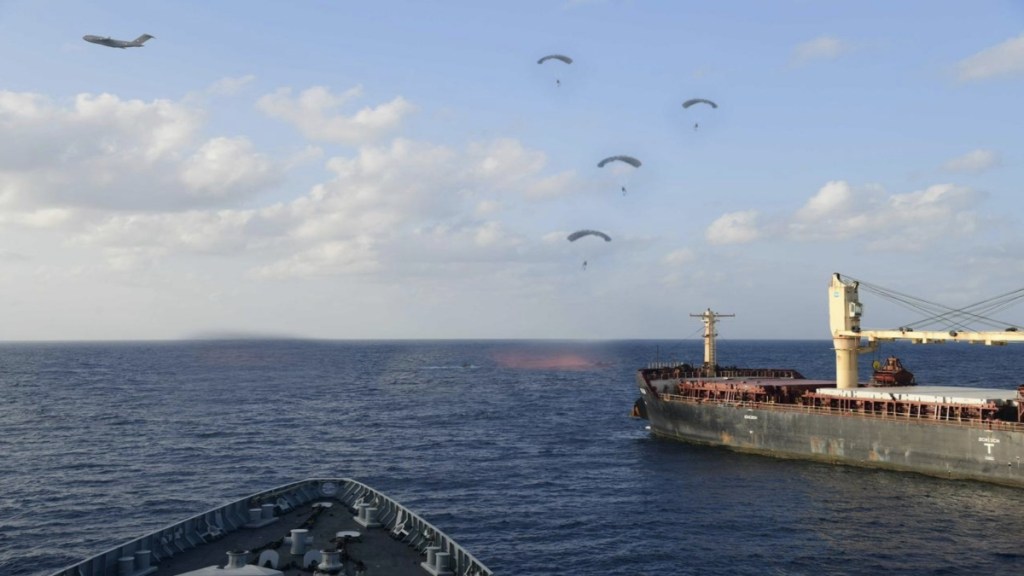Recently, the Indian Navy conducted an operation against Somalian pirates in the Arabian Sea and rescued 17 hostages. Pirates had taken the crew of the MV Rouen hostage on December 14 last year. Seven citizens of the Malta-flagged ship were from Bulgaria. The ship was hijacked by about 35 pirates.
And, it was the indigenously developed Spotter Drone which was deployed to monitor the situation at sea where the pirates had also fired at the drone, highlighting the dangers faced during such missions.
These Spotter Drones are now integral to Indian warships, provide real-time intelligence crucial for maritime operations.
What is the importance of Maritime Spotter Drone?
In an earlier interaction with Financial Express Online, Captain Nikunj Parashar, Co-founder and Managing Director of Sagar Defence Engineering talked about the significance of the Maritime Spotter Drone. “This real-time communication was pivotal, providing mission control with immediate insights into the status of the crew module and facilitating rapid decision-making by playing an essential role in guiding recovery vessels to the precise location of the module.
This not only expedited the recovery process but also enhanced the overall safety and efficiency of the mission. These autonomous systems proved to be instrumental in streamlining the recovery operation, aiming to make human spaceflight missions safer and more efficient in the future,” he explained.
Sixty of these drones have been acquired from Sagar Defence, proving vital in trials where they executed spotting maneuvers at 20 knots and successfully landed on the INS Vikrant, India’s indigenous aircraft carrier. And will boost ISR, protecting seafarers and in aiding interception operations.
What happened on board MV Ruen?
Somalian pirates had converted the MV Ruen into a ‘pirate ship’. As soon as this pirate ship once again launched into the sea with the intention of plundering and hijacking the ship, the Indian Navy became alert. Taking extremely alert and immediate action, the Indian Navy launched an operation against pirates 2600 kilometers away from the Indian coast. In this operation of the Indian Navy, C-17 aircraft of the Air Force airdropped MARCOS (Marine Commandos).
Somalian pirates initially tried to fire on naval warships and drones. Apart from this, an attempt was made to make a ‘human-shield’ for the crew members. But the Somalian pirates, shocked by Marcos’ operation, finally had to surrender. The Navy also released videos of the surrender in which all the pirates are seen sitting on the ship in a semi-nude state.
According to the information, for the first time a large number of pirates have been brought back to India and are in custody here. In earlier incidents, under international laws, the Indian Navy had given the pirates a warning and left them. But this time, the Navy’s patience has run out and, in an effort to send a strong message to the Somalian pirates, the pirates are being brought back to India so that they can be prosecuted as per Indian law.
According to Navy spokesperson, Commander Vivek Madhwal, apart from the warship INS Kolkata, INS Subhadra warship, Sea Guardian drone and P-8I surveillance aircraft were also deployed in this maritime operation. In this operation that lasted for about 40 hours, the Indian Navy not only caught 35 Somalian pirates, but also safely rescued 17 people held hostage by them.
And, nine Bulgarian citizens are also included among the released hostages. This is the reason why everyone from the Bulgarian President to the Foreign Minister has wholeheartedly thanked Prime Minister Narendra Modi and Foreign Minister S Jaishankar.
The PM wrote in response to the Bulgarian President’s X account that “India is fully committed to freedom of navigation in the Indian Ocean and fighting terrorism, including piracy.” Foreign Minister Jaishankar replied to his Bulgarian counterpart that “this is what friends are for.”
In the last few months, the Indian Navy has prevented attacks on several merchant ships in the Western Indian Ocean. Also, in the month of January, in a major operation in the Arabian Sea, the Marine Commandos (MARCOS) of the Indian Navy freed a Liberian merchant ship from the capture of Somalian pirates and rescued all 21 crew members safely. Of the 21 crew members on board the rescued Liberian ship MV Leela Norfolk, 15 were Indian nationals. At that time too, the help of MQ-9 Predator drone, helicopter, P8I aircraft and INS Chennai warship was also taken along with MARCOS in the mission in the North Arabian Sea.
About Spotter Drones
These drones offer unique capabilities, allowing for take-off and landing while ships are in motion. The Spotter drone deal, signed in 2021, includes 30 units, with an additional 60 ordered in 2023. Designed exclusively for the Indian Navy, these drones enhance surveillance, enabling pre-emptive threat detection and real-time information sharing.
Moreover, smaller UAVs launched from carriers expand surveillance range and facilitate communication between vessels, amplifying naval capabilities in coordination with satellites like Rukmani.
Innovations like mid-sea command transfer and passenger-carrying drones, like ‘Varuna’, mark significant advancements. Manufactured by Sagar Defence Engineering, Varuna is designed to operate from moving warships, offering versatility and efficiency in various missions.
Looking ahead, collaborations between Larsen and Toubro and startups signal a promising future, with plans for submarine-launched UAVs and advancements in anti-submarine warfare and ISR capabilities.
Despite past challenges and failed attempts, the Indian Navy remains committed to enhancing maritime security through indigenous UAV technology, ensuring robust defence and surveillance capabilities in the maritime domain.

